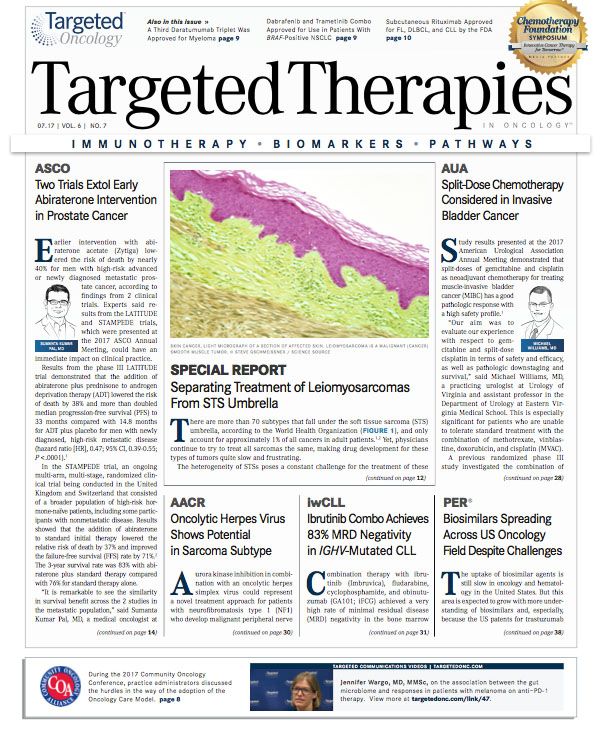Biosimilars Spreading Across US Oncology Field Despite Challenges
The uptake of biosimilar agents is still slow in oncology and hematology in the United States. But this area is expected to grow with more understanding of biosimilars and, especially, because the US patents for trastuzumab (Herceptin) and bevacizumab (Avastin) expire in 2019.
on June 4 in Chicago, panel members sought to explain the basic principles of biosimilar products.
THE BASICS OF BIOSIMILARS
Hope S. Rugo, MD, explained that a biosimilar is a new biologic product that is highly similar to an approved product in terms of structure, function, and biological activity. According to the FDA’s definition, biosimilarity means that the product is “highly similar to the reference product, notwithstanding minor differences in clinically inactive components,” and importantly, that “there are no clinically meaningful differences between the biological product and the reference product in terms of the safety, purity, and potency of the product.”1
The European Medicines Agency has approved more biosimilars than the FDA due to obstacles to US approvals, including regulatory pathways, postapproval surveillance, coverage and reimbursement decisions, clinician and patient perception, and extrapolation, said Rugo, clinical professor, Department of Medicine (Hematology/ Oncology), and director, Breast Oncology Clinical Trials Program, University of California, San Francisco.
Robert Rifkin, MD, added that there are challenges to the uptake of biosimilars even once they are approved, including physician behavior, lack of patient incentive, boots on the ground, professional societies, costs, and conflicts of interest. Overcoming these challenges will require education, said Rifkin, the medical director of biosimilars, McKesson Specialty Health, US Oncology Network.
Presenter Andrew D. Zelentz, MD, PhD, described differences in biologics from a regulatory perspective. Biosimilars and interchangeables, or biosimilars that can be substituted for the reference product, go through the 351(k) pathway with the FDA. Original biologics, “me-too” biologics, and “bio-betters,” or biologics that have been altered to achieve improved outcomes, go through the 351(a) regulatory pathway.
Biosimilar developers do not need to present the FDA with complete data proving full clinical efficacy and safety. This has already been demonstrated by the innovator of the reference product, said Zelentz, medical director of quality informatics, Memorial Sloan Kettering Cancer Center. Instead, the manufacturers must prove that the biosimilars are structurally and functionally similar to the reference product in preclinical assessments, followed by animal toxicity studies.
Clinical trials of biosimilars are then conducted to prove the similarity of the pharmacokinetics and pharmacodynamics to the reference product. “Product class-specific pharmacokinetics equivalence margins are very important for extrapolation decisions that occur later in the development program,” Zelentz said. The agent must also show similar safety, efficacy, and immunogenicity in a phase III trial in comparison with either the US or EU reference product. Phase II trials are not necessary for biosimilars.
“Our biggest problem is getting people onto these trials in the United States,” said Rifkin.
Once an agent’s similarity has been proven in a sensitive patient population, the drug can be extrapolated for use in other indications already approved for the originator drug without necessitating additional clinical trials. It is here, Rifkin said, that the cost savings come in.
BIOSIMILAR LANDSCAPE IN HEMATOLOGY/ONCOLOGY
Rifkin highlighted that there are several biosimilars and non-originator biologicals approved and in development for the supportive care agents lgrastim, peg lgrastim, and erythropoietin and for the therapeutic agent rituximab (Rituxan) in hematology.
Filgrastim rbe (Zarzio), a biosimilar to lgrastim, was approved by the FDA on March 6, 2015. Yet Rifkin noted that it took more than 180 days for the biosimilar to reach the clinic with only a 15% discount from the reference product.
With pegfilgrastim, 351(k) applications have been accepted by the FDA for 2 biosimilars, MYL-1401H and CHS-1701. A biosimilar to epoetin alfa, epoetin hospira (Retacrit) was considered for approval by the FDA but the application was recently denied due to manufacturing concerns.2
The US patent for rituximab expired in 2016, and no biosimilars have yet been approved in the United States. However, several phase III trials of rituximab biosimilars are ongoing, geared toward approval in various hematologic malignancies.
Adam M. Brufsky, MD, PhD, explained that there is a huge market for both trastuzumab and bevacizumab in the United States. This is driving a great deal of biosimilar development, said Brufsky, associate chief of hematology/oncology, co-director of the Comprehensive Breast Cancer Center, and associate director of clinical investigation, University of Pittsburgh.
A number of biosimilars to trastuzumab are currently undergoing phase III trials in the setting of HER2-positive metastatic breast cancer alone; including MYL-1401O, which had a larger phase III trial than for the trial for the reference product, Brufsky noted. In the active study, the drug met the FDA’s required definition of equivalence and similar efficacy. Brufsky commented that with biosimilars, the 90% confidence interval is what is more important in the approval process than attaining the same response rates. He anticipated that an approval for a trastuzumab biosimilar will occur in the next few years in the United States.
Bevacizumab biosimilars are also going through several phase III trials with chemotherapy for nonsmall cell lung cancer. In 1 trial with the biosimilar ABP 215, the objective response rate met the 90% confidence interval margin and so clinical equivalence was demonstrated between the biosimilar and the reference.
References:
- FDA. Scientific considerations in demonstrating biosimilarity to a reference product: guidance for industry. fda.gov/downloads/drugsguidancecomplianceregulatoryinformation/guidances/ ucm291128.pdf. Posted April 2015. Accessed June 27, 2017.
- Pfizer provides update on proposed epoetin alfa biosimilar [news release]. New York, NY: P zer, Inc.; June 22, 2017. investors.p zer.com/investor-news/press-release-details/2017/P zer-Pro- vides-Update-on-Proposed-Epoetin-Alfa-Biosimilar/default.aspx. Accessed June 28, 2017.

Survivorship Care Promotes Evidence-Based Approaches for Quality of Life and Beyond
March 21st 2025Frank J. Penedo, PhD, explains the challenges of survivorship care for patients with cancer and how he implements programs to support patients’ emotional, physical, and practical needs.
Read More